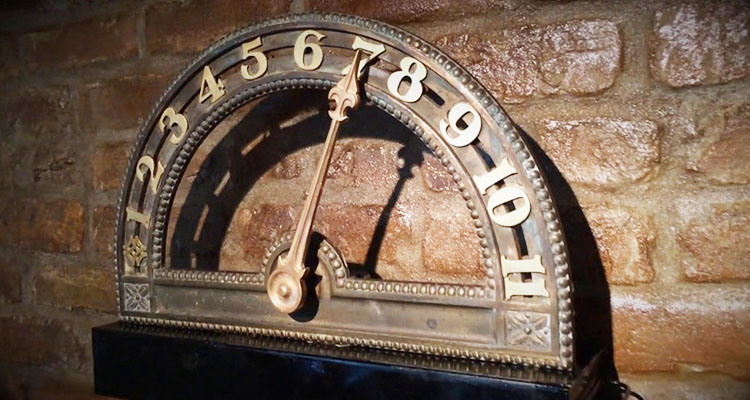Editor’s note: Gone are the days when elevator operators called out “Going up,” but some interesting elevators exist in Wheeling with fascinating features and histories. Today’s Part 1 of “Extreme Elevators” takes a look at a few such contraptions.
We use them frequently and likely give them little thought. Most of us don’t understand how they work. (If you would like to learn more about how they function, click here.) But all of us do know that elevator technology makes our lives easier.According to www.elevators.com, primitive elevators powered by water wheels, animals or people were invented around 300 B.C., and these types of elevators were used for nearly 2,000 years. The first human-powered, counterweighted personal elevator was built in 1743 for King Louis XV of France. It connected his apartment in Versailles to that of his mistress, Madame de Chateauroux, who lived a floor above him.
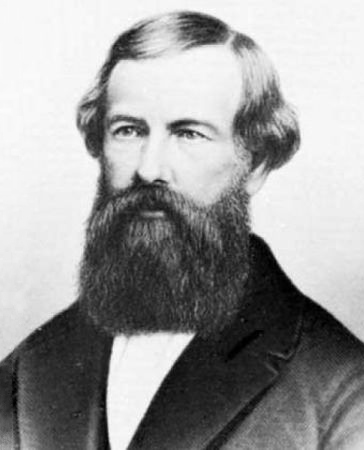
Henry Waterman of New York is credited with inventing the “standing rope control” for an elevator in 1850.
American inventor Elisha Otis demonstrated a new safety device in 1853 that would prevent an elevator from crashing if a cable broke. His invention greatly increased the public’s confidence in elevators and eventually made the creation of modern-day skyscrapers possible. In 1887, the first electric elevator was patented by Alexander Miles, and elevators began to morph into the version that we know and use today.
Nowadays, we step in, push the button for our floor, then scroll through our phones until the doors open mere seconds later.
But those of us of a certain age remember the days of elevator operators calling, “Going up!” and then announcing each floor number as the dimly lit car slowly creaked along from one floor to the next.
Those days are gone, but in some local buildings, elevators still exist with fascinating features and histories.
FIRST STATE CAPITOL BUILDING ELEVATOR, 1413 EOFF ST.
The First State Capitol building at 1413 Eoff St. is now home to law firm Cassidy, Cogan, Shapell & Voegelin, the WALS Foundation and several other businesses. However, on June 20, 1863, it served as the state’s first capitol building of the newly formed State of West Virginia.
In those days, the building did not have an elevator. Patrick Cassidy, who, with his wife Mary Ellen, owns this historic building, tells Weelunk that it was renovated in the mid-1920s by Bertschy’s Funeral Home. Mr. Bertschy modified the building to its current neo-classical look and added the elevator during those renovations. The elevator is much deeper than standard elevators due to Mr. Bertschy’s work as a funeral director.
“The elevator had to be long enough to accommodate the caskets,” says Cassidy.
The elevator is nearly 100 years old and in outstanding working order, Cassidy notes.
“Our elevator company says it could last another 75 years!” he says.
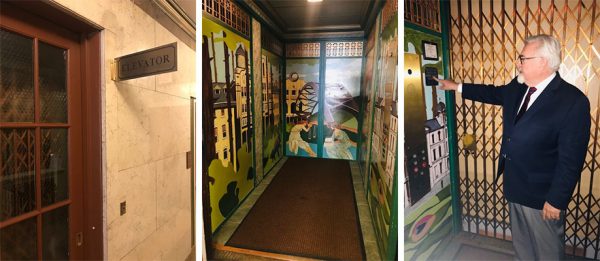
There is only one catch to riding the manually-operated beauty — riders must be sure to close both the expanding inner scissor gate and the main wood and glass doors completely. If the doors are even a fraction of an inch from latching, the car will not budge. Signs warning riders of this caveat are prominently displayed, though not always heeded.
After the Cassidys purchased the building in 1993, they worked to return the building to its former historical glory. Where the vintage elevator car was concerned, however, they made only cosmetic changes. Well-known artist Patricia Croft, formerly of Wheeling, was commissioned around 2015 to paint several architectural murals inside the car. Historical local structures depicted in her murals are the now-demolished Mount de Chantal Visitation Academy and Wheeling’s first City Building, as well as the iconic Fort Henry Bridge.
THE KAYLEX BUILDING ELEVATOR, 1035 CHAPLINE ST.
In the early 1900s, Wheeling was a prime industrial center of the new state of West Virginia. Warehouses and factories were springing up around town, and elevators were needed to move hefty loads of freight from one level to another. Some of these early freight elevators are still in use today.
One of them is located inside the Kaylex Building at 1035 Chapline St. The building is owned by local entrepreneur Dean Connors, who has completely renovated both the building and the interior of the old elevator.
“This elevator was installed between 1908 and 1916,” states Connors, who purchased the Kaylex Building in November 2017. He has renovated and updated the space, which now houses CMS Bankcard Services’ ATM operations center in the basement, the Sexual Assault Help Center on the second floor and the Information Helpline on the third floor. The first floor is currently unoccupied.
Connors tells Weelunk that he has had difficulty learning much history about the brick building itself. Originally, there were houses and a pharmacy along Chapline Street in front of the building, he said. Most of the research he’s done on the address returns information on the houses but not the “old warehouse in their backyards.” He does know that the building was once used as a fruit and vegetable warehouse that supplied Wheeling’s original market house, which was located on what we know as Market Plaza. In subsequent years, the building housed Stenger Office Supply and then Linn Pottery.
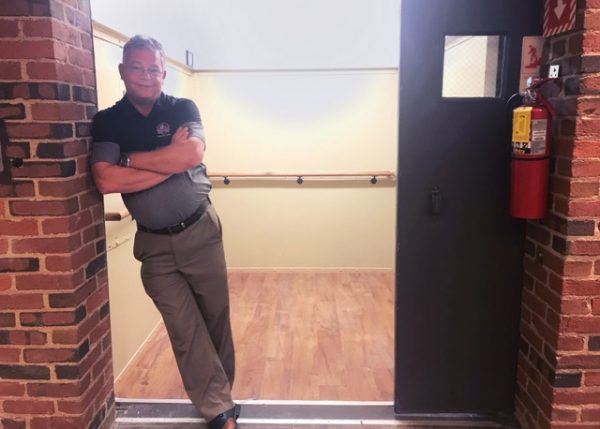
Upon purchasing the building, Connors had the elevator inspected by a certified elevator technician and was told that its original rope system had been replaced with metal cable. Although one would think that wire cable would be stronger, in this case, it was a safety hazard. Connors explained that the emergency braking system was meant to “bite” onto the rope in case of a freefall, and that this catch mechanism would not be able to grab the metal cable in the same fashion.
“Instead of grabbing hold and stopping it, the catch would just continue to slide along the cable. It may slow down the descent, but it wouldn’t stop it,” Connors says. Fortunately, the technician had a high-strength elevator rope in stock and was able to correct the problem quickly. Once the elevator met and exceeded all safety requirements, Connors painted the car’s interior, replaced the old flooring, installed lighting and handrails and restored the brass numbers on each floor.
This elevator lacks several common functionalities seen on most present-day elevators. For instance, the sturdy giant door slides open and closed manually. “Although it’s technically a freight elevator, people can be considered freight,” says Connors. Because it is a freight elevator and the buttons must be held in for the duration of the ride, a responsible “operator” must manually run the car at all times.
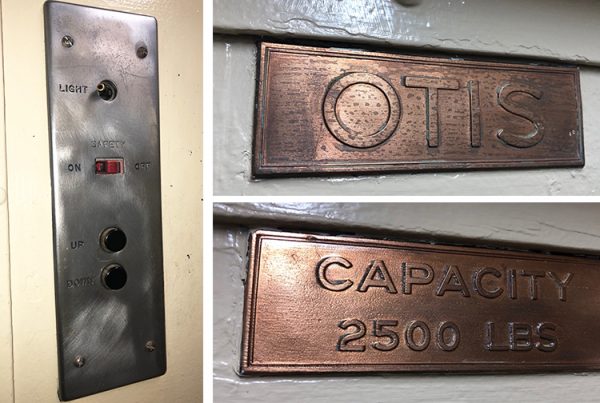
FORMER COLVIG’S MILLINERY ELEVATOR, 1056 MAIN ST.
Connors also shares that he once rode in the tiniest elevator he’s ever seen, located in the now crumbling remains of 1056 Main St. Reincarnated most recently as a bar and nightclub, the building originally housed Colvig’s Millinery where women’s hats were created. In 1908, a gas leak caused a major fire at the millinery, and three young adult women perished in the disaster. According to Connors, local lore has it that the spirits of these three souls haunt the elevator as it was too small to whisk them from the flames to safety.
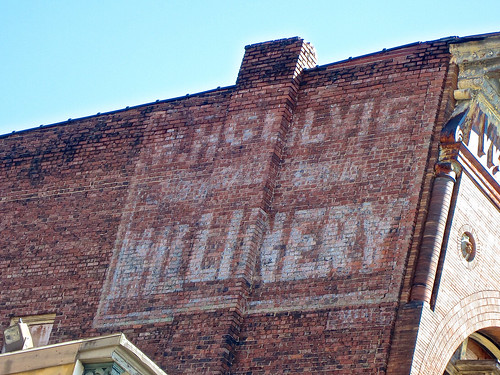
In Part 2 of Extreme Elevators, we’ll see a freight elevator, an interesting renovation and a residential elevette.
• A lifelong Wheeling resident, Ellen Brafford McCroskey is a proud graduate of Wheeling Park High School and the former Wheeling Jesuit College. By day, she works for an international law firm; by night, (and often on her lunch breaks and weekends) she enjoys moonlighting as a part-time writer. Please note that the views expressed in her writing are solely her own and do not necessarily reflect those of anyone else, including her full-time employer. Through her writing, Ellen aims to enlighten others on causes close to her heart, particularly addiction, recovery and equal rights. She and her husband Doug reside in Warwood with their clowder of rescued cats, each of whom is a direct consequence of his job as the Ohio County Dog Warden. Their family includes four adult children, their spouses and several grandkids.


